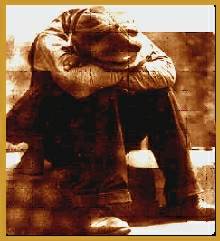|
PinkMonkey Online Study Guide-World History
14. 4 Panic of 1929
Several Americans in the stock market worked as
speculators. They bought when prices were low and sold when the
prices shot up. The speculative demand for stocks was mainly responsible
for the stock market boom of the 1920s. Prices of popular stocks
rose to fantastic heights. Thousands of Americans entered the stock
market hoping to make a fortune. All of them dreamed of instant
money. Wall Street in the 20s had become a huge money-pumping machine.
In other words, America was in a speculating frenzy. Due to mass
speculation, prices touched dizzy heights and soon did not bear
any relation to the actual performance of the companies.
The Bankers too went along with the speculation
madness. They granted loans to brokers to finance the stock speculations.
Though the Federal Reserve Bank Board had powers to limit unbridled
speculation, it did not take action until March 1929. Finally, when
it did try to check the speculation, it was too late. Between June
1927 and September 1929, the price of stocks had shot up from 115
to 225 points. Then onwards the prices declined. Initially the fall
was gradual; later they began to fall at a greater speed so much
so that Roger Babson, an economist predicted: "Sooner or later a
crash is coming, and it may be terrific factories will be shut down...Men
will be thrown out of work...the vicious circle will get in full
swing and the result will be a serious business Depression."
His prophetic words were not given attention by
the bankers, public officials and other economists. The crash of
the stock market began in October. Some of the bankers in New York
formed a pool in an attempt to make the market stable. They did
succeed in stabilizing the market but only for a few days. On October
29th, their efforts to save the market failed, as 16 million shares
were dumped on the market. For the next 2 weeks the market continued
to drop. It is important note that most of the capital lost in the
crash was largely cash reserves of small companies and savings of
the middle-class in the country.

Exhibit 14.2
The Depression left individuals shattered.
The crash of the stock market was only the beginning.
It was followed by an unparalleled business crisis. Slowly businessmen
no longer found it profitable to invest in business and consumers
began to buy lesser goods. Consequently, production of capital goods
and consumer durables fell sharply. As Hicks and Money described
the situation. "Prices dropped sharply; foreign trade fell off;
factories curtailed production, many closed their doors never to
reopen them; real estate values declined; new construction, except
on government works practically ceased; banks went under; worst
of all, wages were cut drastically, and unemployment began to mount."
The Depression spread to Europe and Latin America
due to the contraction of American loans and purchases.
|
Index
14.0 - Introduction
14.1 Republican Ascendancy and World Politics
14.2 The Washington Conference
14.3 Republicanism at Home
14.4 Panic of 1929
14.5 Causes
14.6 Methods to alleviate the effects of Depression
14.7 The Effects of the New Deal
14.8 Impact of Great Depression
14.9 Dates & Events
14.10 Points to Remember
Chapter 15
|